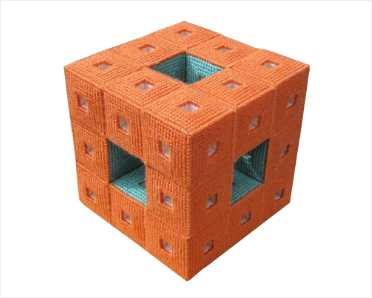In 2014 we were involved with the MegaMenger project, which used business card-size, pieces to make small cubes which were joined together to make various levels of sponge. If you want to know the details go to the web site where you will find information from round the world.
A Menger Sponge is a 3D fractal. It is like a Sierpinski Carpet but in three dimensions. It is named after Karl Menger.The basic idea is that you take a cube and remove a square tunnel from the centre, in all three directions; then you remove a square tunnel, in all directions, from the cubes you have left. Theoretically you can keep on doing this to infinity. The volume gets increasingly small; the surface area gets increasingly large.
Ever since MegaMenger I had been turning over the idea of trying to knit a small version. The finished thing looks simple, symmetrical and logical. However I approached it, it proved to be far too complex to attempt to knit. I wanted to make it about the same size as the version I finally made. I could have done this by making lots of 2 cm cubes and stitching them together but I didn’t really want to do that. I wanted to make at least the second size of cube, or possibly the big cube, all in one go.
Trying to work out the logic of knitting the net, and leaving gaps to put sponges inside, was mind-blowing. After many attempts I gave up and decided to use plastic canvas instead. I thought that, once I had handled the structure sufficiently, I might be able to return to the knitted version. For various reasons, the plastic canvas version proved almost as challenging. I could not make a complete face in one piece because of the complications of what happened on the inside. There are 20 cubes in the finished sponge and each of those has a cross-shaped piece inside to form the smallest holes. Trying to build up a shape that is based on holes is not easy. Joining the cubes together is also tricky when some parts need to be joined inside. There are 120 6 cm squares and 480 2 cm squares and the whole thing is much heavier than you might imagine.
One advantage of plastic canvas is that it is easy to use different colours on different faces. The colours effectively show where the various holes are.
I think I could make a better attempt at a knitted version now but this took so long I don’t think it will ever happen.
To see more photos go to my Ravelry project page.
There is no pattern to make this but we do have a pattern for an illusion knitting wall-hanging. .



